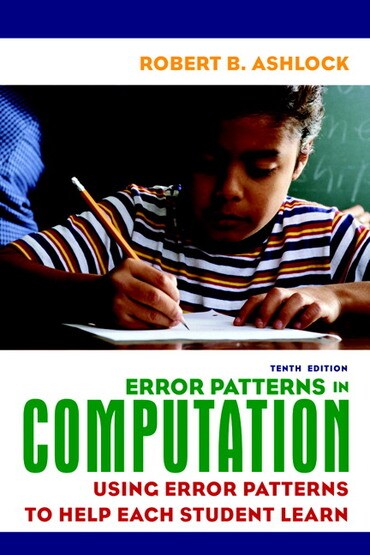
Title overview
- Emphasizes assessment and the role of diagnosis within formative assessment.
- Provides guidance and resources for assessing and interviewing students.
- Incorporates students’ papers in which readers identify patterns of responses and compare their instructional recommendations with those of the author.
- Readers also practice identifying misconceptions and error patterns.
- Focuses on concepts and principles.
- Allows an instructor to teach computation in accordance with the NCTM Standards.
- Gives students an understanding of the meanings of operations and not just methods of computation.
- Enables students to know when particular operations are needed for solving a problem.
- Retains its emphasis on computational fluency.
- Stresses estimation and the best computing choice (mental computation, paper-and-pencil, calculator) in specific scenarios.
- Stresses estimation.
- Encourages readers to ask their students, “Is it reasonable?”
- Provides current strategies.
- Examines models and concrete materials, graphic organizers, self-assessment, portfolios, peer tutoring, and cooperative groups used when teaching computation.
- Incorporates reader recommendations that increase the text’s user-friendly and pragmatic appeal.
- NEW! Gives new emphasis to diagnosis as a part of formative assessment--Teachers can use varied approaches to diagnosis before instruction and also as they intervene during instruction.
- Open-ended assessment and problem writing are examples of procedures illustrated.
- NEW! Supplies more coverage of making connections among facts, procedures, and concepts–Will help teachers and students make connections by applying big ideas.
- Compensation principles, relations between operations, and “There are many names for a number” are examples.
- NEW! Furnishes a distinction between misconceptions and error patterns in computation–Encourages teachers to focus on concept development when appropriate rather than merely reviewing procedures.
- NEW! Offers an increased understanding of our system of numeration–Provides additional material that enables teachers to diagnose understanding of multi-digit numerals at a deeper level.
- NEW! Helps teachers and students to better understand the meanings of operations--additional material is provided to help teachers and students understand the operations of arithmetic so they will know when to use each operation when solving problems.
- NEW! Provides greater emphasis on representations--Teachers are instructed to represent concepts and procedures in a variety of ways.
- NEW! Includes a new section on using classroom discourse--Teachers listen carefully to classroom discourse and then ask questions that probe and guide thinking.
- NEW! Features a new focus on dispositions–Helps teachers to assess disposition.
- NEW! Incorporates a new section illustrating a thematic unit in mathematics--Enables teachers to plan varied instruction that involves connections with other mathematics and numerous applications.
Table of contents
1. Computation, Misconceptions, and Error Patterns
2. Error Patterns: Addition and Subtraction with Whole Numbers
3. Error Patterns: Multiplication and Division with Whole Numbers
4. Misconceptions and Error Patterns: Concepts and Equivalents with Fractions and Decimals
5. Error Patterns: Addition and Subtraction with Fractions and Decimals
6. Error Patterns: Multiplication and Division with Fractions and Decimals
7. Introduction to Misconceptions and Error Patterns: Geometry and Measurement
8. Introduction to Misconceptions and Error Patterns: Percent, Proportion, Integers, and Algebra
Part II: Diagnosis and Instruction
9. Diagnosing Misconception and Error Patters in Computation and in Other Mathematical Topics
10. Providing Data-Driven Instruction in Computation
11. Enriching Instruction in Computation and Other Mathematical Topics
Glossary
Key for Additional Practice
Selected Resources
Appendices
Author bios
Robert Ashlock began his career in 1957 as a fourth and fifth grade teacher with a bachelor’s degree in elementary education. He later received a master’s degree in elementary school administration from Butler University and a doctorate in elementary education from Indiana University. He became a graduate assistant and teaching associate at Indiana University in 1964 and went on to teach at several institutions including the University of Maryland, Reformed Theological Seminary, Belhaven College, and finally, Covenant College in Lookout Mountain, Georgia. Ashlock came to Covenant in 1988 to fill the need for a specialist in elementary education who could also teach on the graduate level. He directed the Master of Education Program, taught both undergraduate and graduate education courses, and coordinated the process necessary for the teacher education program to be approved by the Georgia Professional Standards Commission.
He is one of only two professors ever to receive the title Professor Emeritus at Covenant. He is known throughout the education community for his book, Error Patterns in Computation: Using Error Patterns to Improve Instruction, which is currently in its tenth edition. Although retired, Ashlock continues to teach a few classes.